We’ve all seen them. Funny product reviews from customers who may not be ripe for the stand up stage, but they sure make us chuckle at our screens while we shop.
Certain products are funny by nature. Take the infamous banana slicer. While this invention may have been useful enough for someone to financially back its creation, it’s obvious that most people think it’s a joke.
But that doesn’t mean that there can’t be funny product reviews about serious products. What’s hidden between the lines of sarcastic and silly comments is a real message for other shoppers: I bought the product. I used the product. And here’s what I thought.
And as we’ll demonstrate below, even funny product reviews have implications for brands & manufacturers.
7 Types of Funny Product Reviews
1. The Parental Nightmare Review
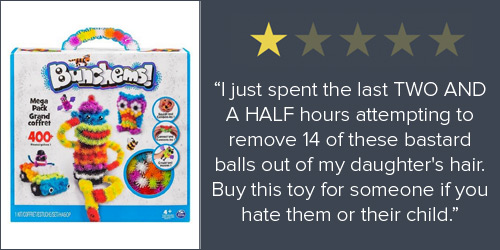 Poor parents. Sometimes you can’t help but laugh at the woes they face day to day. What’s better is when parents can laugh at themselves and the painful experiences they have trying to make life fun for their kids. This example is one of the best funny product reviews we’ve seen; we encourage you to click the image to read the full text. We have to admit this product, Bunchems, looks pretty fun. But according to reviewers, it is fraught with problems. These product reviews are funny, but there is real information here that the manufacturer must hear: these 400+ tiny balls stick to kids’ hair and they are impossible to get out. A pretty monumental product problem that probably should have been caught in initial product testing. But that’s why reading product reviews is so crucial to the people making today’s products. You just never know what’s going to come up in real life scenarios.
Poor parents. Sometimes you can’t help but laugh at the woes they face day to day. What’s better is when parents can laugh at themselves and the painful experiences they have trying to make life fun for their kids. This example is one of the best funny product reviews we’ve seen; we encourage you to click the image to read the full text. We have to admit this product, Bunchems, looks pretty fun. But according to reviewers, it is fraught with problems. These product reviews are funny, but there is real information here that the manufacturer must hear: these 400+ tiny balls stick to kids’ hair and they are impossible to get out. A pretty monumental product problem that probably should have been caught in initial product testing. But that’s why reading product reviews is so crucial to the people making today’s products. You just never know what’s going to come up in real life scenarios.
2. The Degrading Review
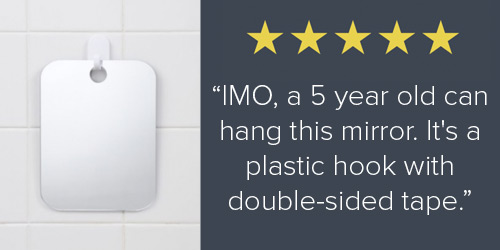 Always a critic. Even though their star average might be glowing, the text sometimes makes fun of other reviewers who had problems with the product. Take this fog-free shower mirror. Many complained about what this person thought a 5 year old could do. What can a brand learn from the degrading review? That the consumers are often on their side. Maybe there isn’t always a reason to respond to a negative review, such as one criticizing the hanging process, because a customer will often become your champion and respond accordingly without your involvement.
Always a critic. Even though their star average might be glowing, the text sometimes makes fun of other reviewers who had problems with the product. Take this fog-free shower mirror. Many complained about what this person thought a 5 year old could do. What can a brand learn from the degrading review? That the consumers are often on their side. Maybe there isn’t always a reason to respond to a negative review, such as one criticizing the hanging process, because a customer will often become your champion and respond accordingly without your involvement.
3. The Hilarious Review
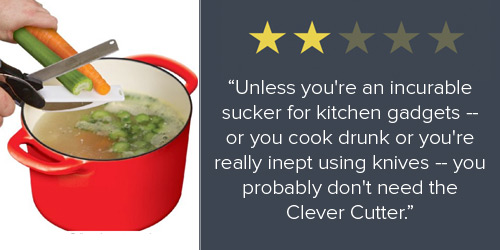 People are a riot these days. The internet has really given consumers a platform to voice their opinion and bring a little humor to life – something we can all use more of. Take the Clever Cutter, which it claims will allow you to “replace your kitchen knives and cutting boards”. Not all reviewers agree, and they have a hilarious way of showing it. This brand should understand that while there might be a time and a place for its invention, it’s not quite to the problem-solution level of completely replacing one’s cutlery set.
People are a riot these days. The internet has really given consumers a platform to voice their opinion and bring a little humor to life – something we can all use more of. Take the Clever Cutter, which it claims will allow you to “replace your kitchen knives and cutting boards”. Not all reviewers agree, and they have a hilarious way of showing it. This brand should understand that while there might be a time and a place for its invention, it’s not quite to the problem-solution level of completely replacing one’s cutlery set.
4. The Blunt Review
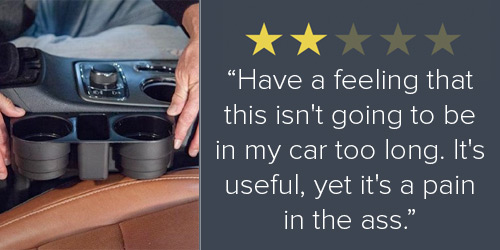
Did you ever have that friend who is so blunt it always makes you laugh? Sometimes the comedy is difficult to detect in a blunt text statement, but if you read carefully, you can often tell whether they are 100% serious or if they are simply stating their feelings with an air of lightness. Take the Car Valet Organizer from Norman Direct. While this product suited the needs of many reviewers who needed more space for cups and other items in their car, for this reviewer it was not a good fit. It hung over the top of the console, is cumbersome changing gears, and it just doesn’t fit right. So, while it’s useful in some ways, this blunt reviewer found it to be a “pain in the ass”.
5. The Reviewer Who Doesn’t Even Know They’re Funny
 Take a look at this review. Don’t you just picture a beefed up frat boy floating down a lazy river with 10 of his buddies, so stoked on the $40 he just spent on Amazon? It might have been the best $40 he ever bought. This type of review is not only funny to readers because of this vision, there’s good information for both shoppers and brands. Brands should take this review and incorporate it in their buyer personas. They can use his same vernacular (“held up like a champ”) in their marketing messaging to connect even better with shoppers.
Take a look at this review. Don’t you just picture a beefed up frat boy floating down a lazy river with 10 of his buddies, so stoked on the $40 he just spent on Amazon? It might have been the best $40 he ever bought. This type of review is not only funny to readers because of this vision, there’s good information for both shoppers and brands. Brands should take this review and incorporate it in their buyer personas. They can use his same vernacular (“held up like a champ”) in their marketing messaging to connect even better with shoppers.
6. The “We Are Laughing at You” Review
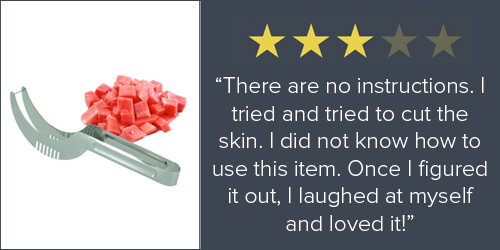
Do you ever get the feeling some people just don’t get it? Especially when shoppers are quick to pull the “buy now” trigger without doing a lot of research. Take this watermelon slicer as case study number one. Although the videos clearly show that the watermelon must be cut in half before the slicer is to be used, not everyone wants to or has time to watch an instructional video. The manufacturer in this case should adjust its messaging so that it’s clear how the product is used. This is a simple way to prevent other unhappy customers and reviews in the future.
7. The Socio Political Commentary Review
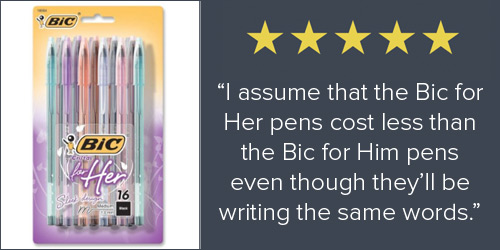 This is an oldie but goodie, and went viral thanks to an Ellen skit that has had over 16.5 million views. The lesson here for brands? While you may see an opportunity and want to tap into a certain demographic, sometimes you needn’t be so blatant. You must think of the social and political consequences of the products you make, your messaging and branding. If you don’t think it through and run it through the consumer testing ringer, reviewers will own you.
This is an oldie but goodie, and went viral thanks to an Ellen skit that has had over 16.5 million views. The lesson here for brands? While you may see an opportunity and want to tap into a certain demographic, sometimes you needn’t be so blatant. You must think of the social and political consequences of the products you make, your messaging and branding. If you don’t think it through and run it through the consumer testing ringer, reviewers will own you.
How Shoppers & Brands See Beyond the Silly
Because 90% of people who look at reviews actually read the review text, they can see through the silliness and glean whether the product will work for them. This is an important point for brands, since most of them are only looking at their star average for a product. This strategy alone will not reveal the reason behind trends or help them know how to improve ROI.
As many of the examples above illustrate, a 5 star review often has critical feedback. And a 1 star review doesn’t always mean the product isn’t redeemable. That’s why it’s important to utilize a service that aggregates product reviews and has some natural language processing or a real human analyst to help make sense of the collective message consumers are trying to get across to a brand.
